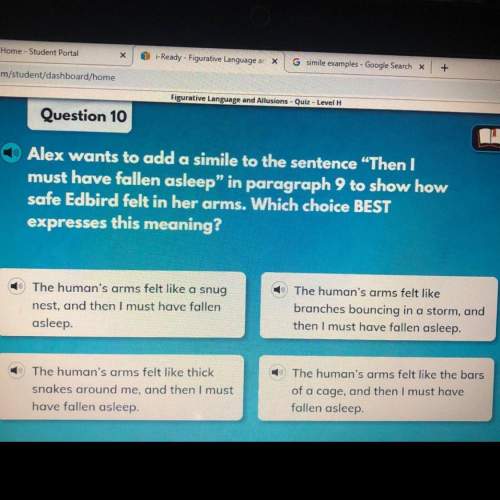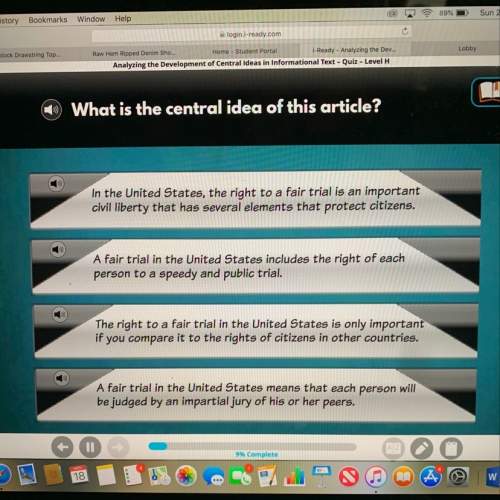
Read the following sentences: "There are many morals and ethical rules in Judaism.
The Torah lays out many of these ethics. These have been discussed, debated, added
to and considered over the thousands of years of Jewish thought."
Based on this information, what conclusion can be made about the development of
Jewish morality?
A Jewish morality has not been influenced by humans.
B) Jewish morality has changed over time.
C) Jewish morality has remained unchanged.
D) Jewish morality has been universally accepted within the faith

Answers: 1


Another question on English

English, 21.06.2019 18:20
Read the following passage: sari couldn't believe her bad luck. she had locked her keys in the car. to add fuel to the fire, her cell phone was in the locked car, and she was late for a very important meeting. she knocked on her neighbor's door so that she could ask to use his phone, but he was not not home. what was she to do? what role does the idiom in the passage serve? a. it shows that sari has incredibly bad luck when it comes to work.b. it shows that sari's neighbor was not home either.c. it shows that sari locked her keys in the car.d. it shows that sari's situation was worse than it seemed at first.
Answers: 1

English, 22.06.2019 04:00
Read the following scene from trifles. sheriff (chuckling). married to the law. (moves toward the other room.) i just want you to come in here a minute, george. we ought to take a look at these windows. county attorney (scoffingly). oh, windows! sheriff. we’ll be right out, mr. hale. (hale goes outside. the sheriff follows the county attorney into the other room. then mrs. hale rises, hands tight together, looking intensely at mrs. peters, whose eyes take a slow turn, finally meeting mrs. hale’s. a moment mrs. hale holds her, then her own eyes point the way to where the box is concealed. suddenly mrs. peters throws back quilt pieces and tries to put the box in the bag she is wearing. it is too big. she opens box, starts to take the bird out, cannot touch it, goes to pieces, stands there . sound of a knob turning in the other room. mrs. hale snatches the box and puts it in the pocket of her big coat. enter county attorney and sheriff.) county attorney (facetiously). well, henry, at least we found out that she was not going to quilt it. she was going to—what is it you call it, ladies! mrs. hale (her hand against her pocket). we call it—knot it, mr. henderson. what changes might a director or screenwriter make to the original version of this scene in order to best emphasize the mood? cut dialogue from the scene to make it a more appropriate length update the setting to appeal to a more modern-day audience omit the actions of the characters to avoid confusion and chaos include the use of lighting, camera angles, and sound effects
Answers: 1

English, 22.06.2019 04:50
Read the passage, then answer the question that follows. no one could have seen it at the time, but the invention of beet sugar was not just a challenge to cane. it was a hint—just a glimpse, like a twist that comes about two thirds of the way through a movie—that the end of the age of sugar was in sight. for beet sugar showed that in order to create that perfect sweetness you did not need slaves, you did not need plantations, in fact you did not even need cane. beet sugar was a foreshadowing of what we have today: the age of science, in which sweetness is a product of chemistry, not whips. in 1854 only 11 percent of world sugar production came from beets. by 1899 the percentage had risen to about 65 percent. and beet sugar was just the first challenge to cane. by 1879 chemists discovered saccharine—a laboratory-created substance that is several hundred times sweeter than natural sugar. today the sweeteners used in the foods you eat may come from corn (high-fructose corn syrup), from fruit (fructose), or directly from the lab (for example, aspartame, invented in 1965, or sucralose—splenda—created in 1976). brazil is the land that imported more africans than any other to work on sugar plantations, and in brazil the soil is still perfect for sugar. cane grows in brazil today, but not always for sugar. instead, cane is often used to create ethanol, much as corn farmers in america now convert their harvest into fuel. –sugar changed the world, marc aronson and marina budhos how does this passage support the claim that sugar was tied to the struggle for freedom? it shows that the invention of beet sugar created competition for cane sugar. it shows that technology had a role in changing how we sweeten our foods. it shows that the beet sugar trade provided jobs for formerly enslaved workers. it shows that sweeteners did not need to be the product of sugar plantations and slavery.
Answers: 1

English, 22.06.2019 07:30
Can you describe the word chalk without saying the words chalk or chalky? (type your own definition of the word.)
Answers: 2
You know the right answer?
Read the following sentences: "There are many morals and ethical rules in Judaism.
The Torah lays...
Questions



Mathematics, 28.08.2020 20:01




Mathematics, 28.08.2020 20:01


Mathematics, 28.08.2020 20:01






Business, 28.08.2020 20:01

Social Studies, 28.08.2020 20:01


Geography, 28.08.2020 20:01

English, 28.08.2020 20:01





